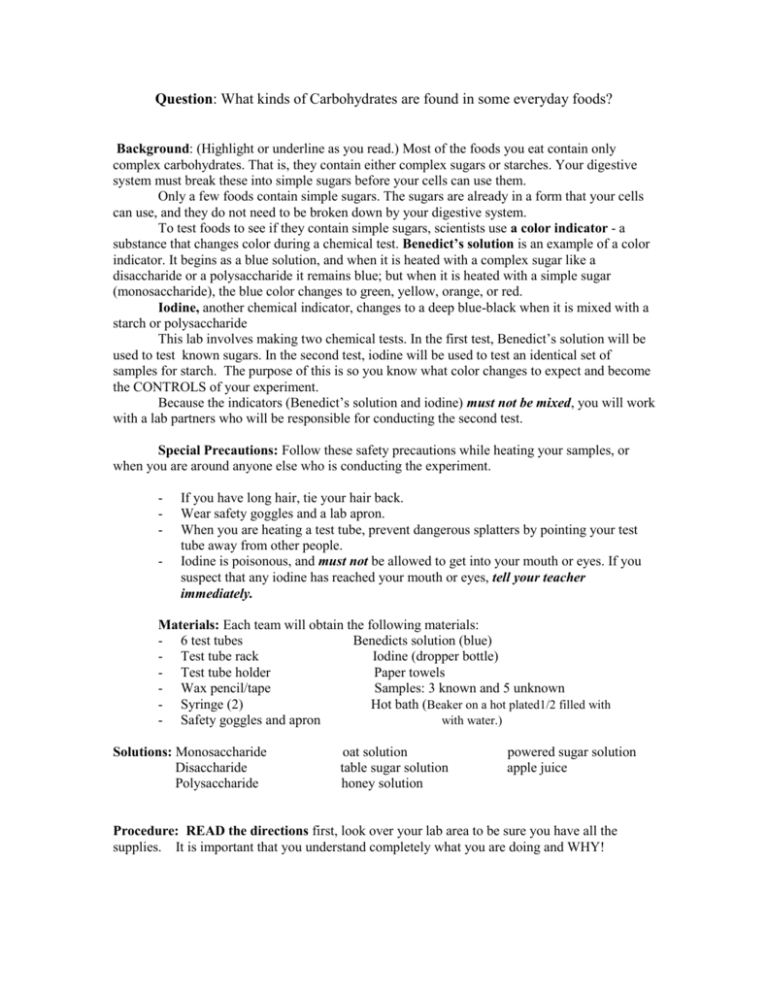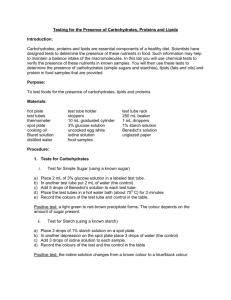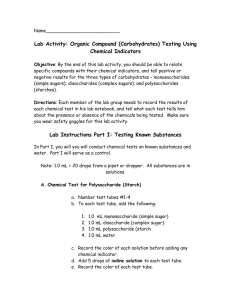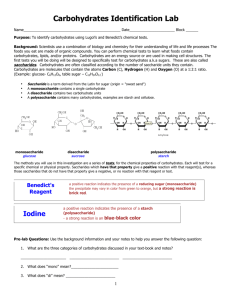Part A. Benedicts. Test
advertisement

Question: What kinds of Carbohydrates are found in some everyday foods? Background: (Highlight or underline as you read.) Most of the foods you eat contain only complex carbohydrates. That is, they contain either complex sugars or starches. Your digestive system must break these into simple sugars before your cells can use them. Only a few foods contain simple sugars. The sugars are already in a form that your cells can use, and they do not need to be broken down by your digestive system. To test foods to see if they contain simple sugars, scientists use a color indicator - a substance that changes color during a chemical test. Benedict’s solution is an example of a color indicator. It begins as a blue solution, and when it is heated with a complex sugar like a disaccharide or a polysaccharide it remains blue; but when it is heated with a simple sugar (monosaccharide), the blue color changes to green, yellow, orange, or red. Iodine, another chemical indicator, changes to a deep blue-black when it is mixed with a starch or polysaccharide This lab involves making two chemical tests. In the first test, Benedict’s solution will be used to test known sugars. In the second test, iodine will be used to test an identical set of samples for starch. The purpose of this is so you know what color changes to expect and become the CONTROLS of your experiment. Because the indicators (Benedict’s solution and iodine) must not be mixed, you will work with a lab partners who will be responsible for conducting the second test. Special Precautions: Follow these safety precautions while heating your samples, or when you are around anyone else who is conducting the experiment. - If you have long hair, tie your hair back. Wear safety goggles and a lab apron. When you are heating a test tube, prevent dangerous splatters by pointing your test tube away from other people. Iodine is poisonous, and must not be allowed to get into your mouth or eyes. If you suspect that any iodine has reached your mouth or eyes, tell your teacher immediately. Materials: Each team will obtain the following materials: - 6 test tubes Benedicts solution (blue) - Test tube rack Iodine (dropper bottle) - Test tube holder Paper towels - Wax pencil/tape Samples: 3 known and 5 unknown - Syringe (2) Hot bath (Beaker on a hot plated1/2 filled with - Safety goggles and apron with water.) Solutions: Monosaccharide Disaccharide Polysaccharide oat solution table sugar solution honey solution powered sugar solution apple juice Procedure: READ the directions first, look over your lab area to be sure you have all the supplies. It is important that you understand completely what you are doing and WHY! Part A. Benedicts. Test 1. Fill a 500 ml beaker half full of water. Bring the water to a boil on a hot plate. The boiling water is called a hot water bath. 2. Number three test tubes 1 to 3. Add 2 ml of monosaccharide solution to tube 1 with your syringe. Rinse out afterward in a CUP of WATER. Add 2ml of the disaccharide solution to tube 2 and 2 ml of polysaccharide solution to tube 3. Rinse syringe after each use! 3. Add 2 ml of Benedicts solution to each test tube (1,2,3) Use a new syringe. 4. Place the test tubes into the hot water bath for 3-5 minutes or just until you see at least one tube change color. 5. Remove the test tubes from the water bath with a test tube holder. 6. Observe ANY color changes in the solutions. 7. Record those changes in the table 1 under the column “Benedicts color”. Part B. Iodine Test 1. Number three test tubes 1 to 3. 2. Add 2 ml of monosaccharide solution to tube 1, 2ml of disaccharide solution to tube 2 and 2ml of polysaccharide solution to tube 3. 3. Using the dropper bottle with the iodine, add 2 DROPS of iodine solution to each test tube. Mix the contents of each test tube by swirling. 4. Record the color of the tubes in the column marked “Iodine color on table 1. Part C. Testing the Unknowns Having tested known carbohydrates, you are now ready to test some unknown substances. By comparing results of the Benedicts and iodine test to the table you just completed you should be able to classify unknown substances as monosaccharide, disaccharides, or polysaccharides. Using the knowledge you have just learned you must now identify the 5 unknowns as either monosaccharides, disaccharides or polysacchrides. EACH person in your lab group will be responsible for writing up and turning in a lab report. This will be on the web site so you can down load it, save it and type on it. You should follow the steps of the scientific method and I have provided a template for you to use for this lab on line. You may want to check the resource section of your text book if you need further explanation for any of the parts. Title Page: Name, Group names, Mrs. Ziebart, Date Purpose or Question: Background: ( Documentation must be included) Most of this information will come from the background section of the lab report. Here is a sample with documentation. Carbohydrates are found in many common foods. A test called the Benedicts test can be used to determine if a sugar is a monosaccharide or simple sugar (lab report). Hypothesis: ( Write your own here and summarize the above hypotheses) Materials : What did you use. Include the controls as well as the unknowns in your write up. Procedure: Summarize in your own words what you did. Number your steps. Observations and Results: Table 1: Results of tests with known carbohydrates. Tube number Carbohydrate type 1 Monosaccharide 2 Disaccharide 3 Polysaccharide Color change after Heating with Benedict’s Color change after Adding Iodine Table 2: Results of tests with Unknown Carbohydrates Carbohydrate Honey Oats Table sugar Apple juice Powered sugar Benedicts Color Iodine Color Type of Carbohydrate Analysis: In a paragraph include the following information. Identify the controls and the variables in this experiment. Why are the controls needed, what did they tell you? Explain how you got your results by writing about the tests. Did the results turn out the way you expected? If not, then give valid reasons as to why they did not. Justify why you needed to test each carbohydrate with BOTH tests. Determine what color changes were necessary for a positive test for Benedicts and a positive test for Iodine. How could one use the information learned from this lab in another situation? This is one of the most important parts of the lab and is counts as the most points. Conclusion: Was your hypothesis right or wrong? Summarize the outcome of the experiment.





